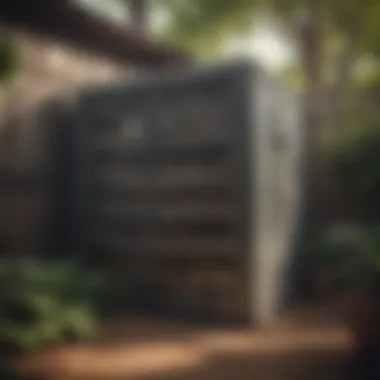Effective Strategies to Keep Snakes Out of Your Yard


Intro
Homeowners often find the presence of snakes in their yards concerning and unsettling. While many snakes are harmless and contribute to the ecosystem, their unexpected appearance can cause unease. Understanding how to prevent these reptiles from invading your personal outdoor space is essential. In this guide, we will delve into practical strategies and methods that can dissuade snakes from taking up residence in your yard while ensuring a safe and pleasant environment.
Design Inspirations
Creating an outdoor space that naturally deters snakes involves thoughtful landscaping and design elements. Here are some key aspects you can consider:
Landscaping Choices
- Native Plants: Utilizing native plants can help. These plants are more adapted to the local environment and can minimize maintenance, which means less clutter that can attract snakes.
- Dense Ground Covers: Avoid dense ground covers where snakes can hide. Instead, opt for well-spaced plants or open areas that may discourage snakes from lurking in the shadows.
Hardscaping Elements
Incorporating hardscape features into your yard can be beneficial:
- Rocks and Gravel: Use rocks and gravel as decorative ground cover. Keep them in tidy areas to avoid creating hiding spots for snakes.
- Paved Walkways: Construct paved paths on your property to reduce the natural habitat snakes may prefer. Paved surfaces interrupt their trails and make movement through your lawn more challenging.
Water Features
Water elements can attract snakes, so plan wisely:
- Dry Stream Beds: If you desire water features, consider dry stream beds; they add aesthetic appeal while minimizing potential snake habitats.
Maintenance and Upkeep
Effectively maintaining your yard is also crucial for snake prevention. Regular upkeep can significantly reduce the attractiveness of your space to these creatures.
Seasonal Maintenance Checklist
- Spring: Inspect your yard. Remove debris, leaf litter, and tall grass.
- Summer: Trim back any overgrown vegetation and keep mulch to a minimum.
- Fall: Clean up fall leaves promptly and check wood piles.
- Winter: Minimize hiding spots by clearing away clutter.
Cleaning and Organization Tips
- Maintain your gardens by regularly trimming bushes and shrubs.
- Store firewood away from the house and off the ground to minimize potential hiding areas.
- Install fencing where necessary, but ensure it is snake-proof and tall enough to deter climbing.
Keeping your yard tidy not only enhances its aesthetic appeal but also decreases the likelihood of snake presence.
By implementing these strategies, homeowners can create an environment that actively repels snakes. Through thoughtful design choices and consistent yard maintenance, it is possible to enjoy your outdoor space without the worry of unwelcome slithering visitors.
Understanding Snake Behavior
Understanding the behavior of snakes is crucial for homeowners wanting to prevent these reptiles from invading their yards. Snakes often play an essential role in the ecosystem, but their presence in residential areas might be unwelcome. Knowing how snakes think and what drives their movements can significantly help in crafting effective deterrent strategies. Several factors influence snake behavior, including environmental conditions, food availability, and habitat preferences.
Common Species in Residential Areas
Different regions have various snake species that commonly inhabit residential areas. Some of these include the Eastern Garter Snake, Western Rat Snake, and even venomous varieties like the Copperhead.
- The Eastern Garter Snake is non-venomous and often found near water sources, gardens, or grassy areas.
- The Western Rat Snake is also harmless but is known to climb trees and invade attics.
- The Copperhead is a venomous snake that typically prefers forests but may venture into yards while seeking food like rodents.
Each species has specific habits and preferences, which can be factors in their presence. Recognizing which snakes are commonly found in your area allows for a targeted and effective approach to prevention.
Factors Attracting Snakes


Certain factors can draw snakes to your yard. Creating an environment that lacks these attractions is pivotal in snake prevention. Consider the following:
- Food Supply: Snakes are often after small animals such as mice and birds. If your yard provides ample food sources, it will likely attract snakes.
- Shelter Locations: Debris, such as piles of wood, rocks, or dense shrubbery, can serve as shelter for snakes, making your yard a desirable habitat.
- Water Sources: Nearby ponds, bird baths, or any stagnant water can attract snakes looking for hydration.
By reducing these factors, homeowners can discourage snake populations from becoming established in their outdoor spaces. It is wise to keep gardens clear of debris and maintain landscaping appropriately.
Crucial Insight: Minimizing food and shelter availability not only aids in snake prevention but also promotes a healthier outdoor space overall.
In sum, understanding snake behavior sheds light on why these creatures may favor residential areas. Homeowners can leverage this knowledge to create an inhospitable environment, thereby reducing the likelihood of encountering snakes.
Environmental Adjustments
Environmental adjustments play a crucial role in deterring snakes from entering residential spaces. By modifying the outdoor environment, homeowners can create conditions that are less favorable for snakes, thus reducing the likelihood of encounters. These changes often focus on eliminating hiding spots and food sources that attract snakes. Additionally, making the yard less inviting contributes to both the safety and comfort of the inhabitants.
Keeping Grass Short
Maintaining short grass is an effective strategy for snake prevention. Long grass provides cover for snakes, making it an ideal habitat for them. Regular mowing can greatly reduce this risk. Aim to keep the grass to a height of around two inches or less. This practice not only deters snakes but also enhances the overall appearance of the yard, promoting healthier soil and plant growth. Shorter grass allows for better visibility, enabling homeowners to spot any unusual activity more easily.
Regular Yard Cleanup
Regular yard cleanup is another important adjustment. Clutter in the yard can attract snakes, providing them with shelter and breeding grounds. Items like piles of leaves, old tires, or discarded furniture can become perfect hiding spots. Homeowners should routinely remove debris, ensuring the yard is tidy and inviting for people rather than snakes.
- Remove fallen branches and leaves.
- Dispose of any unnecessary items.
- Keep compost piles secure and enclosed.
Such maintenance not only makes the yard less appealing to snakes but also promotes an overall healthier ecosystem.
Managing Mulch and Ground Cover
The choice of mulch and ground cover can also impact snake activity. While some organic mulches can provide excellent soil enrichment, they may also create a suitable habitat for snakes if not managed carefully. It is wise to consider using gravel or stones instead of organic mulch. These alternatives do not retain moisture as well as traditional mulches do, making it less appealing for snakes that prefer cool, damp environments. Additionally, avoid letting ground cover plants grow too dense to prevent creating a habitat where snakes can hide.
Effective environmental changes not only protect against snakes but also enhance your overall outdoor space.
By implementing these strategies, homeowners can significantly reduce the chances of snakes infiltrating their yards.
Habitat Modification Techniques
Habitat modification techniques play a crucial role in preventing snakes from entering your yard. By altering the environment, homeowners can create conditions that are less attractive to these reptiles. This section explores various effective strategies, ensuring a safer outdoor space. The essence of habitat modification lies in understanding what snakes prefer and what drives them away. Making these adjustments can lead to a significant decrease in unwanted snake encounters.
Removing Debris and Clutter
One of the simplest yet most effective techniques is removing debris and clutter from your yard. Snakes often seek refuge in piles of leaves, wood, and other debris, where they can hide from predators and rest. By keeping your yard tidy, you can significantly reduce potential hiding spots. Here are some practical steps to follow:
- Regular Maintenance: Schedule a weekly or bi-weekly clean-up to remove fallen leaves, branches, and other organic materials.
- Store Wood Properly: Keep firewood stacked neatly and elevated off the ground, as this can deter snakes looking for a warm, hidden space.
- Check for Unused Items: Regularly inspect sheds and garages for items that can accumulate debris or clutter, and dispose of what is no longer needed.
By minimizing clutter, you make your yard less appealing to snakes, leading them to seek shelter elsewhere.
Making Use of Barriers
Another effective strategy is the construction of physical barriers that impede snake movement. Barriers create a defensive line and can be quite effective when correctly implemented. Here are options to consider:
- Fencing: Install a snake-proof fence that is at least four feet high and buried a few inches into the ground. This prevents snakes from burrowing under it and also deters climbing species.
- Natural Barriers: Consider planting specific hedges that are known to frustrate snakes, such as strong-scented varieties. The smell can keep snakes from venturing close to your garden.
- Rock Walls: Building a low rock wall can serve dual purposes; it deters snakes while also adding aesthetic value to your landscape.
When using barriers, it is essential to ensure that they are maintained regularly, as gaps arising from wear-and-tear can diminish their effectiveness.
Creating Undesirable Conditions


Creating conditions that snakes find inhospitable is an effective means of keeping them at bay. Such conditions can arise from environmental adjustments that deter snakes due to their habits. Here are methods to consider:
- Eliminate Water Sources: Snakes are often attracted to areas with reliable water sources. Ensure that there are no standing puddles or leaking faucets in your yard.
- Limit Food Availability: Snakes feed on rodents and insects. By controlling food supply, you reduce the likelihood of snakes hanging around. Maintain a clean yard by vegetating areas that can harbor rodent populations.
- Use Natural Snake Deterrents: Certain plants, like marigolds, can be helpful in keeping snakes away. The scent can be unappealing for snakes and make your garden a less attractive habitat.
Creating undesirable conditions requires consistency and ongoing effort. Regular assessments of your yard will help ensure these strategies are effective and can potentially turn your property into a snake-free zone.
"An effective approach to snake prevention involves a combination of maintaining cleanliness, building barriers, and altering the habitat to create environments that discourage snakes from feeling welcome."
By implementing these habitat modification techniques, homeowners can take proactive steps in safeguarding their properties from snakes.
Effective Landscaping Practices
Effective landscaping plays a significant role in preventing snakes from entering your yard. By understanding the habits and preferences of these creatures, homeowners can adopt landscaping practices that minimize their presence. Not only does proper landscaping help in creating a less inviting environment for snakes, but it also enhances the overall aesthetic and functionality of the yard.
Selection of Appropriate Plants
Choosing the right plants is crucial in deterring snakes. Certain plants can create a barrier or simply make the environment less attractive to snakes. For example, thorny bushes like barberry can provide a natural barrier. Similarly, some aromatic plants, such as lemongrass and marigold, are known to repel snakes due to their strong scents. When selecting plants, consider:
- Native species: These are more adapted to local conditions and may contribute to environmental balance.
- Dense ground cover: Ground covers like creeping thyme or lavender can reduce open spaces where snakes might hide.
- Avoiding dense foliage: Thick, overgrown areas can serve as hiding spots for snakes. Keep an open and neat planting layout.
It's essential to pair the plant selection with regular upkeep to ensure these plants remain healthy and do not become overgrown.
Designing for Visibility
Designing the landscaping layout with visibility in mind also aids in snake prevention. A clearer view of the yard allows homeowners to spot snakes quickly, reducing unnecessary encounters. Here are some approaches:
- Open spaces: Maintain clear sight lines by avoiding excessive plant growth or large structures blocking the view.
- Defined paths: Create clear walking paths that discourage snakes from moving freely across the yard. Paved paths or decorative gravel can both look good and serve this purpose.
- Low-growing plants: Use plants that stay low to the ground around walkways. This enables easier visibility of any snakes that may be present.
By prioritizing visibility in landscaping, any presence of snakes can be identified sooner, allowing for timely action.
Use of Hardscaping Elements
Incorporating hardscaping elements into the design is another effective strategy. These features can create barriers and discourage snake entry.
- Walls and fences: Installing solid barriers can prevent snakes from slithering into your yard. Make sure to bury the bottom of the fence at least a few inches deep to discourage burrowing.
- Patio areas: Creating paved or gravel patio areas can reduce the amount of soft ground that snakes prefer. These surfaces do not provide good coverage for snakes, helping to keep them at bay.
- Stone or brick borders: These can enhance aesthetics while creating defined boundaries that are less appealing to snakes.
Utilizing hardscaping not only increases the yard's functionality but also contributes to a more controlled environment against snake entry.
Effective landscaping practices, including thoughtful plant selection, visible design, and hardscaping, can significantly reduce the likelihood of snakes entering your yard.
By applying these strategies, homeowners can create a yard that prioritizes both beauty and safety against unwanted snake encounters.
Preventative Measures
Preventative measures are essential in ensuring that your yard remains a safe and pleasant space. Employing various strategies can significantly reduce the likelihood of snakes becoming uninvited guests. By proactively addressing factors that attract snakes and utilizing effective deterrents, homeowners can create an environment that is inhospitable to these reptiles while promoting safer outdoor experiences. The benefits include not only the reduction of snake encounters but also the peace of mind that comes with knowing your yard is less attractive to such wildlife.
Utilizing Repellents
Repellents can serve as an effective tool for deterring snakes from your property. Various types of repellents are available, including chemical and natural options. Chemical repellents often contain ingredients that disrupt the senses of snakes, provoking them to flee the area. These might include substances like naphthalene or sulfur.
On the other hand, natural repellents can be equally effective. Ingredients such as cinnamon oil, clove oil, or a mixture of vinegar and water can be used as a spray around your yard. Applying these repellents in areas where snakes may enter or nest can provide an added layer of protection. However, it is crucial to reapply less persistent repellents after rain or extreme weather.
Additionaly, consider using granular repellents that can be spread in specific areas. Following the manufacturer's instructions is important to achieve the best results. Regular application and strategic placement of these repellents enhance their effectiveness and contribute to a snake-free yard.
Monitoring Local Snakes


Being aware of the snake population in your local area helps in understanding and mitigating potential risks. Monitoring local snakes involves observing their behavior, habitats, and seasonal activity patterns. Some species may be more active during certain times of the year, especially during warm months when they are more likely to wander into residential spaces in search of food or suitable conditions.
Using online resources or local wildlife groups can provide information on common snake species in your vicinity. Engaging in community discussions on platforms like Reddit or local Facebook groups can enhance your knowledge about any recent snake sightings or activity trends. This awareness allows homeowners to adjust their preventative measures accordingly, making it easier to recognize a threat and respond appropriately.
Regular vigilance in your yard, particularly in the early morning or late evening, can also help spot snakes before they find a way onto your property. Noting where they appear can inform further environmental adjustments.
Seeking Professional Help
In some cases, the DIY approach may not be enough to cope with persistent snake problems. Seeking professional help is a rational option. Professionals have the experience, knowledge, and tools necessary to effectively assess the situation and implement long-term solutions. This may involve the safe removal of snakes or even the installation of barriers that prevent access.
Wildlife removal services typically offer consultations to evaluate your surroundings for snake activity. They can give recommendations on modifications to make your yard less appealing to snakes. Moreover, if there are dense populations of snakes nearby, these experts can suggest options for habitat destruction or alteration to address the root cause of the problem.
While hiring professionals involves a cost, it often provides peace of mind, especially for those with children or pets. Additionally, aligning with legal regulations regarding wildlife is important when managing snakes in your area.
Seeking expert advice ensures that you are taking the right steps to create a safer outdoor environment.
By integrating these preventative measures, homeowners can maintain a well-protected yard that limits snake presence. Each aspect discussed reinforces the importance of being proactive rather than reactive when dealing with these creatures.
Legal Considerations
Understanding legal considerations is vital for homeowners aiming to keep snakes at bay. Local laws often govern how to manage wildlife, and ignorance of these regulations can lead to unexpected consequences. It is essential not only to understand what species may inhabit your area, but also to recognize the obligations that come with snake encounters. This section explains key elements of wildlife laws and promotes ethical approaches to snake control.
Understanding Wildlife Laws
Wildlife protection laws vary significantly from one region to another. In many areas, certain snake species are protected, restricted from harm or removal unless specific conditions are met. It is, therefore, crucial for homeowners to familiarize themselves with their local wildlife laws. These laws usually highlight protected species, such as the Eastern Diamondback Rattlesnake or the Gopher Snake, and outline proper reporting channels if these snakes are found within residential areas.
Failing to comply with these laws can result in hefty fines or legal repercussions. Always check with local wildlife agencies for guidance. Many resources are available online, such as state wildlife websites and government publications, that detail legal obligations regarding wildlife in residential areas.
Ethical Approaches to Snake Control
With growing awareness of environmental conservation, an ethical approach to snake control is increasingly sought after. Homeowners should aim for humane solutions to prevent snakes from entering their yards rather than resorting to lethal methods. Some suggested measures include:
- Educating Yourself and Neighbors: Understanding snake species and their behavior can help in creating a safer environment. Knowledge reduces fear and promotes coexistence.
- Creating Safe Havens: Instead of trapping snakes, consider establishing environments that encourage them to relocate, such as designated areas with ample cover away from main living spaces.
- Using Non-lethal Repellents: Experiment with natural repellents that do not harm snakes but deter them from areas frequented by people.
Adopting these methods not only aligns with wildlife laws but also fosters a respectful relationship with nature. Homeowners can contribute to local ecosystems while securing their properties against unwanted snake visitors.
"Approaching wildlife control from an ethical standpoint can enhance community dynamics and support environmental sustainability."
In summary, understanding legal considerations and adopting ethical snake control practices equips homeowners with the tools to create a safer and more harmonious outdoor space.
End
Understanding how to prevent snakes from entering your yard is essential for maintaining a safe and pleasant outdoor space. Homeowners ideally want to feel secure when spending time in their gardens or backyards. The strategies discussed throughout this article emphasize proactive measures that can be taken without resorting to harmful substances or drastic actions.
Review of Key Strategies
To summarize the key approaches:
- Environmental Adjustments: Keeping grass short, regular yard cleanup, and managing mulch can drastically reduce the attractiveness of your yard for snakes.
- Habitat Modification Techniques: Removing debris and clutter, utilizing barriers, and creating conditions undesirable for snakes can greatly diminish their likelihood of entry.
- Effective Landscaping Practices: Selecting appropriate plants and integrating hardscaping can create an inhospitable environment for snakes.
- Preventative Measures: Utilizing repellents and monitoring local snake activity can provide an added layer of security. Seeking professional help is also beneficial when needed.
- Legal Considerations: Understanding wildlife laws is vital. Ethical approaches to snake control not only protect wildlife but also ensure compliance with regulations.
These strategies serve as a comprehensive toolkit for homeowners aiming to keep their outdoor spaces safe.
Encouragement for Consistent Efforts
Implementing these strategies requires commitment. Changes are not often immediate and may need consistent effort and vigilance. Regular yard maintenance and environmental adjustments can be integrated into seasonal routines. The objective is to foster a long-term solution for a snake-free yard.
Each season presents its challenges. Be conscious of natural shifts in snake behavior as they relate to weather and temperature. Adapting your strategies can help maintain the effectiveness of your efforts.
"Consistency is the key to creating an environment that discourages snakes and promotes better outdoor safety."
As a homeowner, establishing an ongoing relationship with your yard is paramount. Regular assessments of your landscaping and surrounding environment will enhance your effectiveness against snake infestations. Ultimately, a proactive approach promotes a safer living space for yourself and your family.







